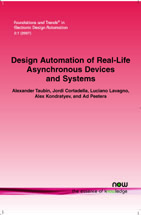Design Automation of Real-Life Asynchronous Devices and Systems
By Alexander Taubin, Boston University, USA, taubin@bu.edu | Jordi Cortadella, Universitat Politècnica de Catalunya, Spain, jordi.cortadella@upc.edu | Luciano Lavagno, Politecnico di Torino, Italy, lavagno@polito.it | Alex Kondratyev, Cadence Design Systems, USA, kalex@cadence.com | Ad Peeters, Handshake Solutions, The Netherlands, ad.peeters@handshakesolutions.com
Abstract
The number of gates on a chip is quickly growing toward and beyond the one billion mark. Keeping all the gates running at the beat of a single or a few rationally related clocks is becoming impossible. In static timing analysis process variations and signal integrity issues stretch the timing margins to the point where they become too conservative and result in significant overdesign. Importance and difficulty of such problems push some developers to once again turn to asynchronous alternatives.
However, the electronics industry for the most part is still reluctant to adopt asynchronous design (with a few notable exceptions) due to a common belief that we still lack a commercial-quality Electronic Design Automation tools (similar to the synchronous RTL-to-GDSII flow) for asynchronous circuits.
The purpose of this paper is to counteract this view by presenting design flows that can tackle large designs without significant changes with respect to synchronous design flow. We are limiting ourselves to four design flows that we believe to be closest to this goal. We start from the Tangram flow, because it is the most commercially proven and it is one of the oldest from a methodological point of view.
The other three flows (Null Convention Logic, de-synchronization, and gate-level pipelining) could be considered together as asynchronous re-implementations of synchronous (RTL- or gate-level) specifications. The main common idea is substituting the global clocks by local synchronizations. Their most important aspect is to open the possibility to implement large legacy synchronous designs in an almost "push button" manner, where all asynchronous machinery is hidden, so that synchronous RTL designers do not need to be re-educated. These three flows offer a trade-off from very low overhead, almost synchronous implementations, to very high performance, extremely robust dual-rail pipelines.
Design Automation of Real-Life Asynchronous Devices and Systems
The number of gates on a chip is quickly growing toward and beyond the one billion mark. Keeping all the gates running at the beat of a single or a few rationally related clocks is becoming impossible. However, the electronics industry for the most part is still reluctant to adopt asynchronous design due to a common belief that there is a lack of commercial-quality Electronic Design Automation tools for asynchronous circuits.Design Automation of Real-Life Asynchronous Devices and Systems presents design flows that can tackle large designs without significant changes with respect to synchronous design flow. Limiting it self to the four design flows that come closest to this goal it starts by overviewing the most commercially and technically proven, Tangram. The other three flows, Null Convention Logic, de-synchronization and gate-level pipelining, can be considered as asynchronous re-implementations of synchronous specifications. Design Automation of Real-Life Asynchronous Devices and Systems demonstrates the possibility of implementing large legacy synchronous designs in an almost "push button" manner negating the need to re-educate synchronous RTL designers. It is essential reading for designers and researchers in large scale integrated circuit design.
